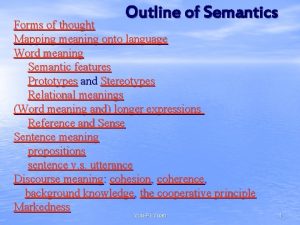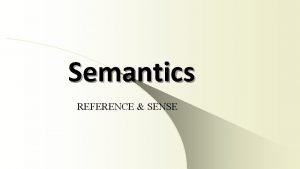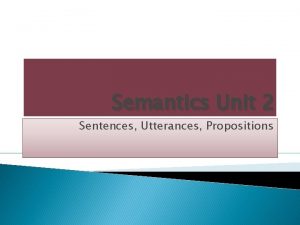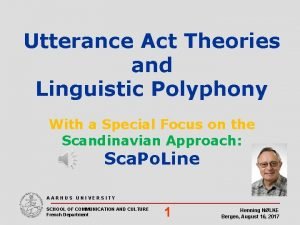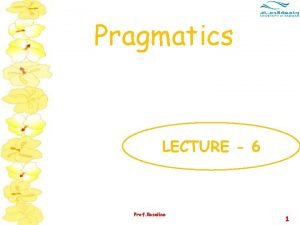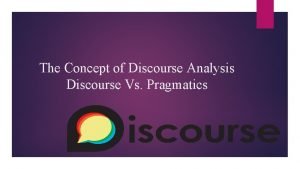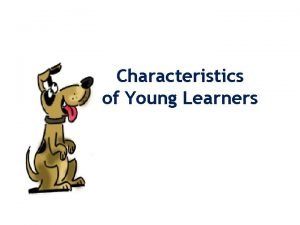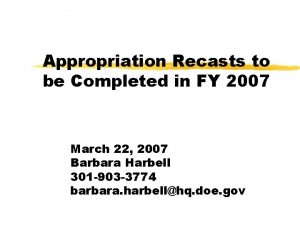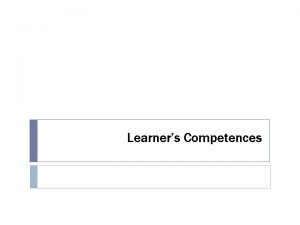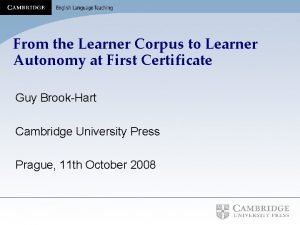The teacher recasts the learners utterance Learner No












- Slides: 12


The teacher recasts the learner’s utterance • Learner: No go disco this Saturday. • Teacher: Oh so you’re not going to the disco this Saturday. This affords the learner an overt comparison between his erroneous utterance and the target form and an opportunity for the learner to carry out the kind of the mental comparison hypothesized to assist the restructuring of the L 2 system However, for such restructuring to take place, the learner will need to engage in some analysis of the recast. That is, the learner needs to compare not just ‘no go’ with ‘you’re not going’ but rather the underlying negative patterns (i. e. ‘no + verb’ and ‘auxiliary + not + verb’). Only then can the learner recognize that the target version of his utterance is ‘I’m not going’. In other words carrying out a cognitive comparison may often involve more than just attending to the surface differences between the learner’s own utterance and the target language input.

Main points 1. ‘Focus-on-form’ refers not just to form but to form-function mapping. 2. Focus on form was first introduced as a pedagogic approach (Fon. F) that was seen as an alternative to a structured-based approach (i. e. Fon. Fs). Subsequently, however, focus on form came to be viewed as a set of procedures for attracting attention to form that can figure in both approaches.

Main points 3. The scope of pedagogic focus on form has expanded considerably over the years, however. Initially, it referred to the interventions designed to attract learners’ attention to form while they performed a communicative task. Later it was expanded to include interactive and non-interactive ways of drawing attention to form both prior to and after performance of a task. 4. Central to all kinds of focus on form instruction, however, is some kind of meaning-focused task that provides the context for the focus on form. Thus focus on form is integral to task-based language teaching.

Main points 5. There is well-defined psycholinguistic dimension to focus on form. To understand this it is necessary to consider, in particular, the role of selective attention and cognitive comparison in language learning as these occur when learners process language in their working memories. The limited capacity of WM constrains what learners can attend to while communicating and thus influences what they can focus on and learn. 6. There is also an important discoursal dimension to interactive focus-on-form. Descriptive research has identified a number or pre-emptive and reactive strategies that can be used to address form and how these strategies impact on learner production (for example, uptake with repair) and learning.

Main points 7. Experimental studies of focus-on-form have shown that it facilitates L 2 acquisition although this depends on a number of factors such as the salience of the focus on form and the learners’ L 2 proficiency. Reactive focus-on-form (i. e. corrective feedback) has been shown to be especially facilitative although focus on form undertaken pre-emptively also aids learning as does non-interactive enhanced input. 8. Pre-task planning and task-repetition have been shown to influence how learners orientate to the performance of a communicative task and impact on the complexity of the language involved.

Main points 9. Fon. F as a pedagogic approach has been the subject of considerable criticism. Many of the objections are spurious resting on the misconception that it constitutes a uniform approach consisting solely of task-induced interaction and on the failure to acknowledge the substantial empirical evidence that lends support to it. 10. Calls for comparative studies of Fon. F and Fon. Fs have been answered but the research to date does not allow a clear answer as to their relative effectiveness. There is evidence, however, that Fon. F results in richer types of classroom interaction that benefit the incidental acquisition of nontargeted features.





Ενδεικτική βιβλιογραφία Doughty, C. & J. Williams (eds. ). (1998). Focus-on-form in Classroom Second Language Acquisition. Cambridge University Press. Eckman, R. , Highland D. , P. W. Lee, Mileham J. & R. Rutkowski Weber. (1995). Second Language Acquisition Theory and Pedagogy. Mahwah, N. J. : L. Erlbaum Associates. Ellis, R. (2012). Second Language Classroom Research and Language Pedagogy. Malden, USA: Wiley-Blackwell. Fotos, S. & Nassaji, H. (eds. ). (2007). Form-focused instruction and teacher education. Oxford University Press. Μπέλλα, Σ. (2011). Η δεύτερη γλώσσα – Κατάκτηση και διδασκαλία. Αθήνα: εκδ. Πατάκη.
 Eager learning examples
Eager learning examples Utterance definition linguistics
Utterance definition linguistics Reflective meaning examples in semantics
Reflective meaning examples in semantics When did english language start
When did english language start Semantics is
Semantics is Pxgotmgt
Pxgotmgt Utterance linguistics
Utterance linguistics Invisible meaning in pragmatics
Invisible meaning in pragmatics Pragmatic definition in linguistics
Pragmatic definition in linguistics Good afternoon teachers
Good afternoon teachers Erf process
Erf process Involuntary attention meaning
Involuntary attention meaning When is cognitivism beneficial for learners
When is cognitivism beneficial for learners

